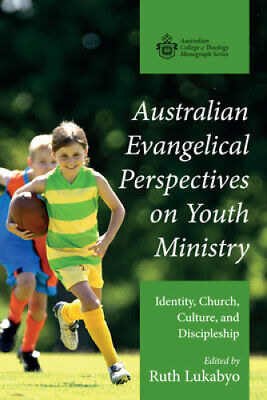I owe a youth movement called Christian Endeavour a big debt. Because it was at one Sunday meeting of Christian Endeavour that I fist declared myself to be a follower of Jesus Christ.
You won’t find Christian Endeavour in many churches these days. But my memories came flooding back when I read a description of it in an essay in Australian Evangelical Perspectives on Youth Ministry edited by Ruth Lukabyo and launched last week.
My experience does not quite fit the description in the essay by Timothy Paul Jones, professor of apologetics and chair of family ministry at Southern Baptist Theological Seminary, the lone American among a heap of Australians in the book.
Because the Christian Endeavour (CE) meetings ran on Sunday afternoon in my hazy memory, leaving me free to be in church Sunday Morning and Evening. But Timothy Paul Jones tells the story of the formation of Christian Endeavour during the industrial revolution as part of the beginning of youth ministry running parallel to the main church ministry. In his essay he recounts the inspiration for CE as being inspired by the Young Peoples Association of Lafayette Avenue Presbyterian in Brooklyn, New York.
“’Stimulated and guided’ by an article about the Young People’s Association, Francis Clark launched the Society for Christian Endeavor in 1881. By this point, youth societies could already be found in many churches; Clark’s Society for Christian Endeavour seems to have provided a worldwide federation that drew these disparate societies together. In a mere ten years, Christian Endeavor grew from one group with fifty-seven young people embracing the pledge to 16,274 societies with nearly one million youth enrolled.
“The connection between local congregations and Christian Endeavor societies seems to have been looser than the link between the local congregation and the original YPA. At the height of Christian Endeavor’s popularity, it was, in fact, “greatly feared that [these societies] would divide the church on the basis of age, and supplant the church in the affection of the young.”
It is with some relief that reading Timothy Paul Jones’ essay allows one to no longer solely blame Elvis, the Beatles, or the youth movements of the sixties for the age-segregation of the churches. His main point is to argue for the church as family — or rather as an integrated multi-generational church.
Timothy Paul Jones makes the link between CE and the rise of other mutual societies in the industrial revolution. The Ragged Sunday School movement might have been a good parallel for him to mention as another example of working class religion combining with social progress.
But his analysis is insightful about class, describing the twentieth century rise of the youth ministry expert as an example of Taylorist management, the church adopting the rise of the management expert.
Here is how he argues for church as family. “Building inter-generational connections and congregational diversity does not, in my estimation, require the elimination of age-organized activities or generational specializations. What a thoroughgoing church-as-family ministry does call for is the development of a church culture in which segmentation and specialization become exceptional instead of assumed.”
Here’s a quibble. Would it be better to describe church as “tribe” rather than “family”? What other similes might have a better fit?
His arguments parallel more secular discussions of community, that teenagers having significant other adults outside of the nuclear family is important for their development. It’s one way that church is a real benefit.
For me growing up, Christian Endeavour leaders, Sunday School teachers and the general set of adults in church shaped my conviction that Christianity could be a whole of life commitment.
That was in a local church, which had the distinction of not belonging to any denomination. It was a remnant of a time when local “Christian” churches in small settlements were founded by Tom Playford, a church-planting ancestor of Tom Playford the long-serving Liberal Country League premier of South Australia.
This made my experience of church fit the ecclesiology of D. B Knox, with the gathering of the local church where the word is preached, not a denomination or other structure, the actual church. In effect I was a Sydney Anglican in form before I ever knew they existed. Chase Kuhn’s essay on this idea of church, goes on to make the essential point about age-specific ministries – “These ministries are churches. Therefore, they must be pastored accordingly”. While he goes on to agree with Jones, that the ideal church as represented in Scripture is inter-generational, he is a moderate — the rethinking he calls for is not to disband specific ministries but to carefully work out how congregations / churches should relate to each other.
Here is how Kuhn describes a practical problem: “For instance, we draw on older youth for kids’ ministries or university students for youth ministries. This is a good practice, especially as this is the natural sequencing of inter-generational ministry. However, this can often top-out leadership at university aged members. These members are often without mentors and there are often members of the youth and children’s ministries who come from broken homes. Their example of maturity in the Christian life in these ministries is restricted to leaders a few years older than them, without Christian mothers and fathers, or grandmothers and grandfathers to model life to them.”
Tim Beilharz points to research on what characteristics of church serve youth best, advocating for “third places” that are neither home not work. “Assessing churches as third places will give us criteria through which we can assess how the environment is affecting faith formation in our children. If our churches are accessible and accommodating places on neutral ground where our children are on the level with adults and each other, if quality conversation is being had with (not just to or about) children with a community of regulars, if the space keeps a low profile so as not to intimidate anyone, and a playful mood helps the child to feel that this truly is a home away from home, then we will be creating a healthy, warm, loving, supportive community. As Christian leaders, this sociological reality coheres with the biblical testimony of the gathering church, through which we entrust that God will grow in children a cognitive, affective, and active faith, centred on Christ and enacted into the world.”
A key word in his description is “warm”.
This piece has focussed on three chapters on the theme of “church” in this white ranging book. We may return for more. Lukabyo has gathered a tribe of thoughtful writers that are worth pursuing on their other themes of culture, identity and discipleship — too rich a mixture to deal with in a short article.

Australian Evangelical Perspectives on Youth Ministry: Identity, Church, Culture, and Discipleship. Edited by Ruth Lukbyo, 2024.
Published in the Australian College of Theology Monograph series by Wipf and Stock Publishers.


I give deep thanks to God for what CE and its leaders did for me (in Adelaide 🙂 )